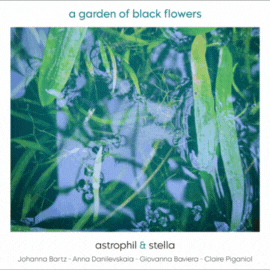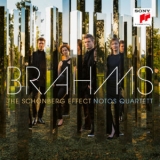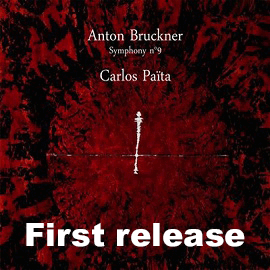 The Schoenberg Effect; Johannes Brahms: Klavierquartett Nr. 1 op. 25; Symphonie Nr. 3 F-Dur op. 90 (Arrangiert für Klavierquartett von Andreas N. Tarkmann); Notos Quartett (Sindri Lederer, Violine, Andrea Burger, Viola, Philip Graham, Violoncello, Antonia Köster, Klavier); 1 CD Sony Classical 194398480022; Aufnahme 04/2020, Veröffentlichung 19/03/2021 (72') – Rezension von Remy Franck
The Schoenberg Effect; Johannes Brahms: Klavierquartett Nr. 1 op. 25; Symphonie Nr. 3 F-Dur op. 90 (Arrangiert für Klavierquartett von Andreas N. Tarkmann); Notos Quartett (Sindri Lederer, Violine, Andrea Burger, Viola, Philip Graham, Violoncello, Antonia Köster, Klavier); 1 CD Sony Classical 194398480022; Aufnahme 04/2020, Veröffentlichung 19/03/2021 (72') – Rezension von Remy Franck
Was ist der Schönberg-Effekt, auf den der Titel der CD hinweist? Nun, er kommt daher, dass Arnold Schönberg das g-Moll-Quartett von Brahms orchestrierte und das Notos Quartett den umgekehrten Weg geht: es ließ für diese CD die 3. Symphonie für Klavierquartett bearbeiten. Der Schönberg Effekt wird also geradezu auf den Kopf gestellt, statt der Erweiterung der kleinen Form erfolgt die Reduktion von groß auf klein.
Zunächst aber erklingt das g-Moll-Quartett op. 25 von Johannes Brahms. Die vier Musiker spielen voller Energie und mit geballter Ausdruckskraft. Dabei bleibt der Klang immer homogen und sehr gewissenhaft im Rhythmus. Es geht hier primär nicht um Äußerlichkeiten, die ins Ohr stechen sollen, sondern um den gemeinsamen Willen, zusammen Musik zu machen, in einer plastischen Deklamation eine Interpretation anzustreben, die auch wirklich Sinn macht.
Die Hauptattraktion der CDs aber ist die für Klavierquartett transkribierte 3. Symphonie. Der deutsche Komponist Andreas N. Tarkmann hat zweifellos eine sehr gute Arbeit geleistet, denn die Symphonie erlangt eine neue Eigenständigkeit, und der Hörer vermisst das Orchester aber auch gar nicht. Das liegt freilich auch an dem engagierten Musizieren des Notos Quartetts, das mächtig in den ersten Satz einsteigt und diesen dann kraftvoll, aber auch schön differenzierend entwickelt. Zweifellos hören wir hier die richtigen Brahms-Farben, und auch der symphonische Atem geht in keinem Moment verloren. Das Allegro con brio ist wuchtig, spannungsgeladen, warmblütig, lyrisch, beseelt sowie voller Leidenschaft und lässt die Stimmungsumschwünge sehr deutlich werden.
Das Andante bleibt bei aller Kantabilität nie bloß nett und lieblich, sondern hat eine latente Unruhe und wirft ernste Fragen auf, die allerdings in den beiden letzten Sätzen nicht komplett beantwortet werden, schon gar nicht im Poco Allegretto, das zwar anfangs wunderbar beschwingt singt, dann aber immer verhaltener und unsichererer wirkt. Diese Stimmung setzt sich zunächst im Finalsatz fort, bis sie dann kraftvoll weggewischt wird. Der letzte Satz zeigt Brahms in hellster Erregung zappelnd, formidabel drängend und dem Schluss zustrebend. So muss diese Musik klingen, ob im Original oder arrangiert.
What is the Schoenberg effect that the title of the CD refers to? Well, it comes from the fact that Arnold Schoenberg orchestrated Brahms’ G minor quartet and the Notos Quartet takes the opposite approach: they had the 3rd Symphony arranged for piano quartet. The Schoenberg effect is thus virtually turned upright down; instead of expanding the small form, there is a reduction from large to small.
The Quartet starts with the G minor quartet op. 25. The performance is full of energy and concentrated expressiveness. The sound always remains homogeneous and agreeably rhythmic. It is not primarily a matter of outward appearances that should catch the ear, but of the common will to play together, to strive in a vivid declamation for an interpretation that really makes sense.
The main attraction of the CDs, however, is the Third Symphony transcribed for piano. The German composer Andreas N. Tarkmann has undoubtedly done a very good job, for the symphony acquires a new individuality, and the listener does not miss the orchestra at all. But this is also due to the committed playing of the Notos Quartet, which enters weightily into the first movement and then develops it powerfully, without neglecting to differentiate the music in the right way. There is no doubt that we hear the right Brahms colors here, and the symphonic breath is not lost at any moment. The Allegro con brio is massive, tense, warm-blooded, lyrical, soulful as well as full of passion and allows the mood changes to become very clear.
The Andante, for all its cantabile nature, never remains merely nice and sweet, but has a latent restlessness and raises serious questions, which are not completely answered in the last two movements, certainly not in the Poco Allegretto, which sings wonderfully buoyantly at first, but then seems increasingly restrained and uncertain. This mood initially continues in the final movement until it is powerfully wiped away. The last movement shows Brahms in the brightest excitement, formidably urging on toward the conclusion. This is how this music must sound, whether in the original or arranged.

























